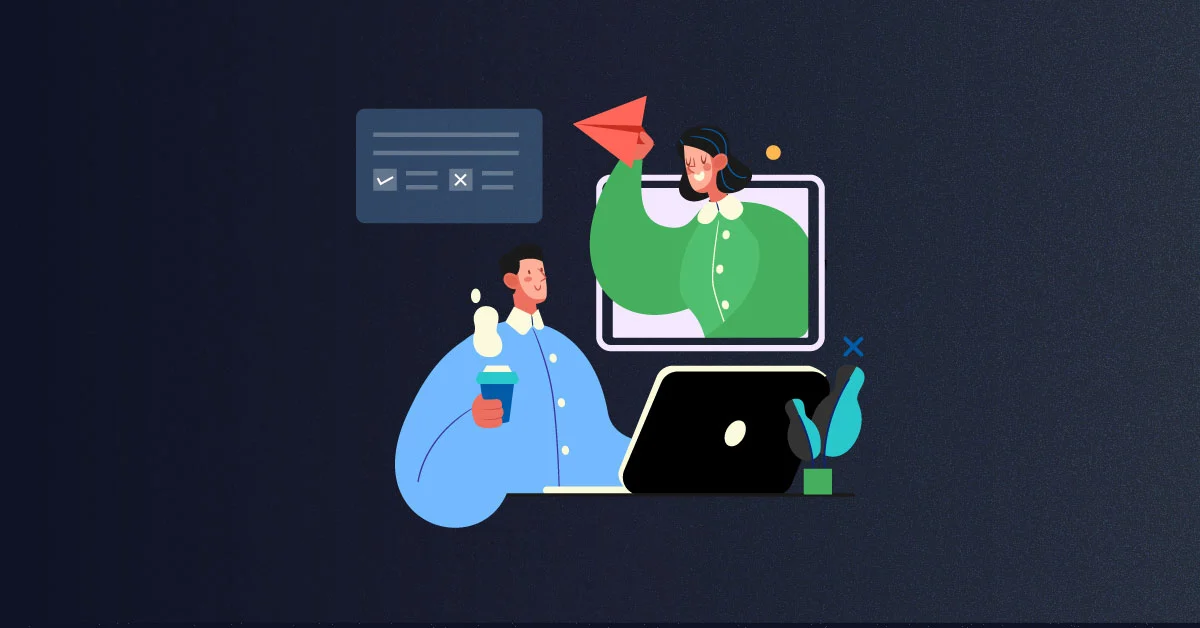The year 2020 had been one with extraordinary challenges as well as a great amount of learning. In the face of these unprecedented challenges, there has been a dramatic shift of the business ecosystem – especially in Learning and Development. As we look forward, L&D leaders must embrace a broader role within the organization and formulate an ambitious vision for the function. And an essential component of this effort is a comprehensive, coordinated strategy to mitigate the risks ahead and focussing on business outcomes.
Scott Margason, Executive Vice President of Client Success of Infopro Learning along with David Wilson, the Founder and CEO of Fosway Group, share their insights on mitigating challenges that face L&D today. With Nolan Hout, Vice President, Marketing of Infopro Learning, as the mediator, the session brings out the benefits of an outcome-based strategy to overcome the challenges around L&D, that most organizations grapple with.
Listen to the Podcast to learn more:
Question:
What do you think the greatest risk is that L&D organisations are facing today?
Question:
How can L&D leaders taking this challenge up of leading from the front?
Question:
How can you create priority and alignment within L&D to achieve organisational goals?
Question:
What are some of the exciting things in L&D that we can look forward this year?
Expert profile:

Scott Margason, Executive Vice President of Client Success of Infopro Learning – A full-service L&D organization, that enables companies to achieve greater potential by leading transformational development.

David Wilson, Founder and CEO of Fosway group – Europe’s and one of the World’s leading HR industry analysts, providing leading research and insights for next gen HR talent and learning.

Nolan Hout, Vice President of Marketing of Infopro Learning – A seasoned marketing professional with experience in every avenue of marketing including strategy, digital marketing and more.
An excerpt of the discussion follows:
Nolan: Hello, everyone, and welcome to the podcast presented by Infopro Learning. Today, we are going to talk about some of the more changes to come in the learning and development landscape. What do you think the greatest risk is that L&D organisations are facing today?
David: I think one of the most significant risks that L&D faces now, is most obviously, responding to the level of change going on within a company. If they able to move at the pace that the business needs to move at, that is another huge challenge. And the risk for them, stems from the fact that historically, L&D has tended to be, not necessarily a leader organisation from an innovation perspective. So they have had to move very fast in the early stages of the pandemic. But being able to really continue to evolve and to respond to what the business really needs – and to be able to do that in a meaningful way – that’s the greatest challenge of all. I think, the risk also is that we tend to focus on the lowest common denominator kid of solutions. These solutions help reach people and roll out things quickly. But it is not the same as rolling them out effectively. So, I would say probably in combination, it is both about being able to respond to the continued level of change and being able to do that in an effective way to drive outcomes for the business.
Scott: I agree with what David has said. And as I look at the greatest challenges or greatest risks that L&D organisations face, I really believe it comes down to two words status quo. In other words, we must lead with the business rather than follow. In 2020 we had to be very, very reactive and it was one of the most challenging year globally in our lifetime. And every leader L&D leader, had to scramble to adjust and address the COVID pandemic. The first three months we hoped and expected it would pass quickly. The next three months reality set in. That’s when we started thinking on how to settle in and long-term strategies. So, it really comes back to how do we move forward in a way that helps the business, adapt very quickly within the new business conditions. And it cannot be status quo.
Nolan: L&D leaders need to define what that new normal is. And it is a tremendous opportunity that is given to us. David, could you share how leaders taking this challenge up of leading from the front?
David: Yes, we should not underestimate the level of change that L&D has been through the past few months. It has been phenomenal in terms of complete pivot away from what in many cases a largely face-to-face driven training. I think looking ahead, we need to focus on training that will be led digitally. And I think that is a huge risk that we need to really focus on.
L&D leaders are focussing on how to prioritise – what is important for business. A lot is us do get overwhelmed by the number of online activities we engage with. It is important for L&D leaders to focus on the activities that really make a difference, drive individual and team productivity and so on. As we move ahead, we have passed the transition to digital mode and we have seen huge increases in utilisation of digital platforms. But what we really need to do is focus on that business outcome piece. L&D cannot second guess what business outcomes need to be. The engagement between L&D and the business leaders must be a lot more intimate in terms of employing innovative strategies and being able to deliver business outcomes.
Nolan: Scott, would you like to add a little bit how you are seeing organisations mitigate some of these risks by channelising L&D focus to business outcomes?
Scott: It comes back to our perspective. And that is why that that change in perspective is so important. When we focus on that culture of learning, we need to create a vision for what that looks like, because people thrive with a vision. Think about the last time that you tried to do a puzzle without the box top – it is frustrating. Without the L&D vision, it feels exactly like that. We do not know where to go, or how to put together and we can’t use rational thinking. And yet, if we can create this vision, people know where we’re headed, and then everyone can get on board. We can all build toward that vision. And that vision is anchored on the outcomes.
Nolan: And so, Scott, how does this outcome focused strategy help reduce the risks that businesses are facing today?
Scott: Stephen Covey has articulated so succinctly – begin with the end in mind. It is essential that as L&D leaders focus on outcomes. To mitigate risks, learning activities cannot be just transactional, or purely statistical. They must be created with the end outcome in mind. And it is clear, we have ask questions – Why are we doing something? Why is the business headed this way? Why is it important for the organisation to have behaviours, skills capabilities that will enable that achieving those outcomes. And so, risk mitigation is about understanding these outcomes associated with the business. For example, if you are a call centre, the very most important thing you can do from L&D perspective in Onboarding, is speed up the time to someone being proficient. That is an outcome that directly translates to the business that reduces their costs. If it is inbound and outbound, it increases their revenue. It has an immediate and direct impact on that. These business outcomes are based on learning and development, developing people to be more proficient, within the least amount of time.
David: Learning development and HR has typically far too many things on its plate at any point in time. And one of the biggest challenges I think, for L&D is trying to innovate and move to newer strategies. One of the things that have changed this year is that a lot of L&D functions, have simplified their agenda and are now focussing on a few things that really are important for busines. And I think another challenge in terms of moving forward is being able to maintain that level of simplification and focus. We need to put our virtual L&D eggs, if you like, into the baskets that ultimately are going to drive value and drive outcomes for us. That will enable an organisation to be more agile and more resilient.
We can get very fixated about the specific things we have to do. But in some ways, the challenge is often clearing the space to do that. And what can we stop doing to create that space, and to do that in an intelligent way – that is often the challenge too. A lot of L&D initiatives stopped this year because it just was not feasible. We now must ascertain what is important in the long term, identify what is imperative to the ongoing success of the business and to the culture of the business.
There is the risk that if we are not careful, we could lose very important things if we only focus on the lowest common denominator kind of solutions. We must focus on the ends that we are trying to achieve. If L&D can get that balance – set the priorities straight and focus on the result, the organization benefits and reaps positive outcomes.
We must not forget that all of this has tremendous economic impact on companies worldwide. And while some companies obviously have thrived and expanded during this period, the vast majority have grappled with the challenges. So, now more than ever, there is more focus on results of where L&D investments are being directed.
Our own research highlights that 95% of organisations have invested in L&D strategy this year – that is a very significant percentage.
Nolan: What advice can you give to other L&D executives that are looking to create that bridge to create priority and an alignment within their organisation to the organisational goals?
Scott: That’s a great question, Nolan. And I believe it comes down to communication and proactive measurement. In other words, we need to open and maintain a dialogue with the business leaders. Not in a reactive sense, but instead helping frame the discussion about how L&D can make an impact in in enabling the organisation to be prepared and transform. We must communicate and proactively get the conversations going.
Also, many of us are not measuring what we do. And without measuring, we lack having a tangible framework to show cause and effect. If we start measuring, we share what we’re measuring and we use it in our dialogue, it will naturally refine the measurement. The business will start to understand how L&D directly aligns with business objectives. This will help build a closer partnership between L&D and business.
David: Measurement of L&D impact is an interesting topic. We have certainly seen examples of both L&D and business being reluctant to measure the actual impact of training. And I think partly the challenge here is L&D itself has been an order taker for too long.
We should avoid making “measurement” into an industry. If we are not careful, we can create an industry around measurement that does not add a lot of value. L&D may follow the classic Kirkpatrick reporting and share metrics, to be distributed across the business. But if nobody even opens it, let alone actually acts on it in any meaningful way – is that not a waste of effort? Focusing and understanding how to interpret data and put that in modern context of learning is important.
Nolan: Is there a downside of measurement, if things go down for reasons completely out of our control?
David: First, we need to understand what metrics the business already values. The important thing is being able to really focus on those measures and not invent artificial values on those things. At the end of the day, if you can drive value and show an impact against measurements that businesses already taking, you will get buy ins that you want. You will get alignment around that and do not need to create an artificial case to put in front of leadership to claim that you are saving millions. I would focus on real measures that business already values. Sometimes there’s room for discussion around what some of those things are and really understand the things that are going to drive value. That does not necessarily mean a direct dollar amount, but to be able to meaningfully measure through a variety of activities. At the end of the day, if you can focus on some simple metrics, that is more valuable.
Nolan: What are some good use cases that you have seen, about organisations connecting L&D to outcomes?
Scott: I can share a particular case where employee engagement was lower than it needed to be. And it was impacting sales and thus business was suffering. As a solution, we focused on developing behaviours and characteristics within the organisation. In other words, how supervisors can supervise more effectively and helping them be more empathetic. And what we found in developing some of those softer skills, the overall employee engagement level increased.
And that increase in employees being more engaged, translated into outcomes, improvement in the business. And so, you do not have to reinvent the wheel, pick up on what is important to the business and start there. And then if we just extrapolate that back to understand what we can do through learning and development in the organisation, that will enable those ultimate outcomes. This approach can really make a huge difference.
The second example is in the whole employee onboarding approach. When we can accelerate the impact that a new person joining an organisation, it has a huge downstream impact. And so, if we can shorten that time to proficiency, or if we can take them to a higher level in that same amount of time, that will result in higher productivity and output. This is also an outcome that is important to the business.
Nolan: And with that we come to the end of this discussion. To end on a positive note, what are some of the exciting things that we can look forward this year?
Scott: Most of us will be happy when we see 2020 in the rear-view mirror. But a lot of that is because of the overwhelming challenges associated with the year. If we look forward, we can look forward to a new perspective that is not incumbered by old traditions. We will still conduct instructor-led training in classrooms, but it will be far less than before. It is a fact that, the transformations that have set in this year, we will be more open to change and trying newer strategies around L&D.
David: 2020 has been challenging, no doubt. But if I am being optimistic and looking ahead, we have a lot of work around understanding how we can come out of the challenges of this year. But there has been a recalibration of what was “business as usual”, that had been slowing us down. That is something positive. In our research over last couple of year, more than 70% of organizations have shared that they are in the process of digital transformation. This year, they have had to do it within 3 weeks! There have been significant changes and if we can focus on the new opportunities because of change, that is a very positive thing that we can all look forward to this year. The renewal mode is fruitful in terms of new opportunities and strategies.
Nolan: My answer is that I look forward to the learning! We have learned so much this year and I hope this trend continues. Thanks for joining in – do check out another riveting discussion led by Scott Margason and David Wilson – Using the New Normal to create a Competitive Advantage. We will be sure to keep sharing more sessions like this, looking forward to learning together!



